5.18 Maytas ESFA Release Notes
Note regarding submissions
We would like to remind providers to create a submission early and check for any errors using reports from the appropriate software (i.e. the FIS or LLWR-Inform). Welsh providers should also remember to download their ULI file. After submission to the ESFA or DfES, providers should check that data has submitted correctly using the available reports. Providers should check that all their expected starts and completions are submitted correctly, and that start and outcome payments correctly match the PFR or ACE funding reports.
Our support desk gets extremely busy in the days prior to the submission deadlines, and although we try and prioritise submission-related queries, we cannot guarantee assistance if queries are sent late. If you do encounter any issues, please ensure that you contact Maytas Support as soon as possible, as we can only rectify issues of which we are aware. We also recommend checking Maytas Communities regularly for information on any known issues and solutions. Tribal cannot be held responsible for any issues caused by your failure to comply with this advice.
Data migration
Please note that it is important to ensure that all 2018/19 learners have been entered before the upgrades are applied. This is because the upgrade migrates 2018 data to the 2019 fields, and any 2018 learners entered after the upgrades will not be migrated. As such, if any 2018 learners do need to be entered after the upgrade, both the 2018 and 2019 tabs must be completed to ensure all data is present and correct.
Technical specification
The latest Maytas and e-track technical specification can be found here.
Once the upgrade has been completed, the version number should be checked to ensure it has been successful.
- Start Maytas and go to Support on the toolbar.
- Click About.
- The version numbers should read 181.20 / 5.18.7101.5. If you have any other version, please ensure you have followed the upgrade instructions correctly. If you require assistance, please contact Maytas Support.
It is the responsibility of customers to ensure that users carry out any required user acceptance testing and sign off on the upgrade.
Complete the Upgrade
Features Added in the Upgrade
These are the main updates in the upgrade:
- ILR tabs for 2019/20
- ILR reports for 2019/20
- ILR rollover validation rules for 2019/20
- ILR rollover funding for 2019/20 using 2018/19 rules
- ILR batch export
- Lookup changes for new and revised fields
- Fixes to a number of issues
Reports Library 1.0.3.2 is also included in the upgrade but must be installed separately. This is detailed in the Upgrade Guide. If you are a hosted customer, please contact the Service Desk to arrange for the reports library update to be applied.
Check the Contractor Details for the ESFA Export
- Open Maytas 5 and select Management | Contracts.
- Highlight the contractor name (company) you wish to edit.
-
Right-click and select Edit.
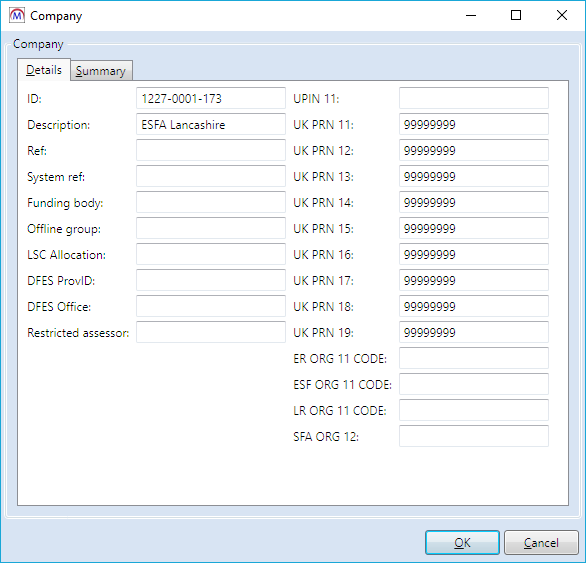
- The Company screen will be displayed. The technical upgrade will have copied the UK PRN field to the new 19 box. If necessary, you should amend this value.
- Providers need to ensure that these instructions are completed for each company (contractor) used for the ESFA export.
Create the 2019/20 ESFA Formula-Funded Contract
A 2019/20 ESFA formula-funded contract should be set up for each ESFA contractor. Without this contract, Maytas is unable to determine the funding rules, schemes and lookup codes to use.
- In the Contracts module, left-click the contractor (company) to which you wish to add the new contract.
- Click Add Contract on the ribbon.
-
Make sure that option 1. Existing company is selected then click Next.
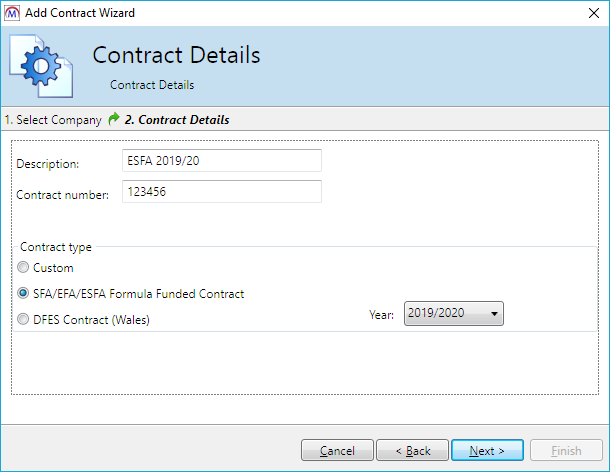
- Enter a contact description (e.g. ESFA 2019/20).
- Enter a contract number if required.
- Select the SFA/EFA/ESFA Formula Funded Contract option.
- Select year 2019/2020.
- Click Next.
- Amend the schemes you wish to include in the contract and click Next.
- Click Finish.
The Contract Wizard will create the appropriate funding model within Maytas and set up all of the schemes that apply.
Re-Import the FIS Data Sets
IMPORTANT - The FIS for 2019/20 is completely different to previous years. It does not currently include the data sets that are uploaded to Maytas, and so only allows submissions to be imported and validated. Our intention is to allow .CSV files for the LARS, postcode data, etc, to be imported into Maytas instead, but files for 2019/20 are not yet available.
For now, we recommend that providers continue to upload the 2018/19 FIS data sets into Maytas, though as of this upgrade it is not clear if this will include LARS updates for 2019/20. We will update providers with our plans around this as and when further information becomes available.
It is essential that the latest aim information is imported into Maytas for use by the ILR export. This should be done by importing the relevant information directly from the Data Service’s Funding Information System (FIS). To do this, you must have the FIS installed and correctly configured (please refer to the Data Service’s instructions for setting up the FIS).
Please ensure you have the latest version of the FIS with the latest components installed.
Once the FIS is installed and configured, the information can be imported as follows:
- Perform a sync in Maytas 5, then restart Maytas 5.
-
Go to Exports | Uploads | Upload FIS Data Sets.
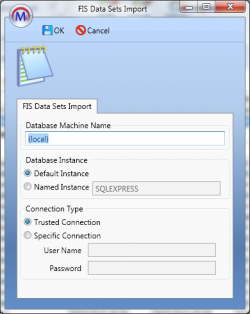
- There are three items to configure:
- Database Machine Name – If the FIS is installed on the same machine that you are using for Maytas 5, this can be left as (local). Otherwise, enter the machine name of the SQL server where the FIS database is held.
Database Instance – If the SQL server holding the FIS database has a named instance (e.g. MACHINENAME\INSTANCENAME), select Named Instance and enter the instance name. Otherwise leave this as Default Instance.
If you have no named instance and Default Instance does not work, you may need to select Named Instance and leave the instance name blank.
- Connection Type – This is the login for the SQL server holding the FIS database. Trusted Connection will use Windows authentication. If you wish to specify the login details, select Specific Connection and enter the credentials.
- Click OK. The FIS data will now be imported.
- If you have an Adult Skills budget contract and a transition factor, this must be entered on the contract:
- Go to Management on the toolbar and click Contracts on the ribbon.
- Select the relevant contractor, then select the Adult Skills contract on the right.
- Click the
 button.
button. - Go to the Uplifts tab.
- Enter the ASB Transition Factor and click OK.
- Click Apply to save the change.
Note on the Funding Cache
By default, the funding cache will update overnight so that funding information in Maytas uses the newly-imported FIS and postcode information. Please check with your system administrator if you are unsure if or when the funding cache is updated on your system. You can also manually set the funding cache to update by going to Management | Profiles and clicking the Funding Cache button, though please be aware that this may take a long time and may use a large amount of system resources, which could affect performance for other users on the system.
Maytas 5 Version 5.18.7101.5 Release Notes
2019/20 Contract Year Updates
New Contract Year Tabs
New Maytas tabs for 2019/20 have been produced for the ILR and LLWR as per specifications from the Data Service and DfES. These will have been imported automatically in the upgrade. Please note that while both ILR and LLWR tabs are imported, the relevant tabs will only show for the relevant learners – i.e. ILR tabs will only show to learners on English schemes and LLWR tabs will only show to learners on Welsh schemes. Details of the tabs can be found below.
Please note that user permissions will need to be set for the new tabs, as by default they are available to all users. Also please note that if you have changed the field type for any ILR fields (e.g. to or from a lookup), these will need to be changed from the default field type in the screen designer.
ILR Changes for 2019/20
These are the main ILR changes for 2019/20 which have been implemented in Maytas:
New Tabs for 2019/20
There are six new ILR tabs for 2019/20:
- ILR 2019 App (starter and leaver info) – These are intended for learners on Apprenticeships.
- ILR 2019 16-19 (starter and leaver info) – These are intended for 16-19 (excluding apprenticeship) learners, including Traineeships funded through the 16-19 funding model.
- ILR 2019 Other (starter and leaver info) – These are intended to be used for all learners who are not on Apprenticeship or 16-19 schemes, including 19-24 Traineeships.
As in previous years, the tabs have been designed so that only the appropriate tabs appear for each scheme. However, we are aware that many providers have bespoke or non-standard scheme groups. In these cases, it is possible that the tabs may not appear on certain schemes. This can be rectified in the following way:
- Check the group type of the scheme (SCHEME.GROUPTYPE).
- In Maytas 5, go to Tools on the toolbar and click New / Load on the Screens panel.
- Select Trainee on the left.
- Double-click the ILR tab which is not appearing. The tabs for 2019/20 are:
- ILR 2019 App Starter Info
- ILR 2019 App Leaver Info
- ILR 2019 16-19 Starter Info
- ILR 2019 16-19 Leaver Info
- ILR 2019 Other Starter Info
- ILR 2019 Other Leaver Info
-
Alter the Scheme group as required. Each group should be separated with a comma (no spaces). For example, if the App tab is not showing for scheme 3, and the group type for scheme 3 is called MY_GROUP, the tab should be set as in the screenshot.
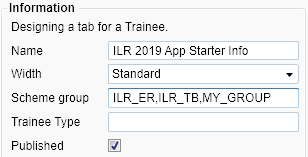
- Click Apply to save the changes.
New Fields
There are three new ILR fields for 2019/20:
- Learning start date postcode – This appears in the main aim and sub aims sections on the ILR App and ILR Other starter tabs.
- Planned hours– This appears in the programme aim section on the ILR App starter tab.
- Devolved area monitoring (DAM) – This appears in the main aim and sub aims sections on the ILR App and ILR Other starter tabs.
Additionally, each aim now has six Learning delivery monitoring (LDM) fields rather than four.
Removed Fields
The Off-the-job training hours field has been removed from the ILR. This was previously in the Learner Information section of the ILR App starter tab.
Notes on Continuing Learners and Migration
As part of the upgrade, data for continuing learners is migrated from the 2018/19 fields to the 2019/20 fields. Any changes to continuing learners and any late-notified learners entered after the upgrade should be completed on both the 2018/19 and 2019/20 tabs. This is because certain ILR fields are recorded in different fields in the database from year to year, and therefore it is important to ensure that all data is completed and correct on both tabs.
The following fields are NOT migrated from 2018/19 to 2019/20:
- Learner reference number in previous year
- UKPRN in previous year
- Accommodation
- Learning support cost
- Planned learning hours
- Planned EEP hours
- GCSE maths qualification grade
- GCSE English qualification grade
- High needs students
- Learner support reason
- Special educational needs
- Eligibility for 16-19 (excluding Apprenticeships) disadvantage funding
- GCSE maths condition of funding
- GCSE English condition of funding
- Free meals eligibility
- Pupil premium funding eligibility
- Financial support type (HE)
- Financial support amount (HE)
It is important to ensure these fields are completed on the 2019/20 tabs where required.
ILR Reports for 2019/20
The ILR reports have been created using the available ILR guidance for 2019/20. Providers should check with the ESFA that they are happy for the current reports to be used and that it is compliant for audit purposes. As this has been the case for the reports in previous years, we do not expect any issues in this regard.
There are reports available for apprenticeship, 16-19 (excluding apprenticeships) and non-16-19 learners.
The ILR reports are automatically imported in the upgrade and can be found in the ILR folder of the Reports Library.
There are two ways to run the reports:
- On the Home tab, select Report Library | ILR and select the required report. This will let you search for a learner and choose whether to show codes or descriptions for the fields. It will also let you select the sections to show.
- In a learner record, click Process and select the appropriate ILR 2019/20 process. This will open a PDF export of the report for the learner / POT. It will use the default of showing code values.
ILR Export 2019/20
The ILR export for 2019/20 is now available in Maytas. To view the ILR export screen for 2019/20:
- Click Exports on the toolbar.
- Click ILR Export on the ribbon.
-
Click the
 button.
button.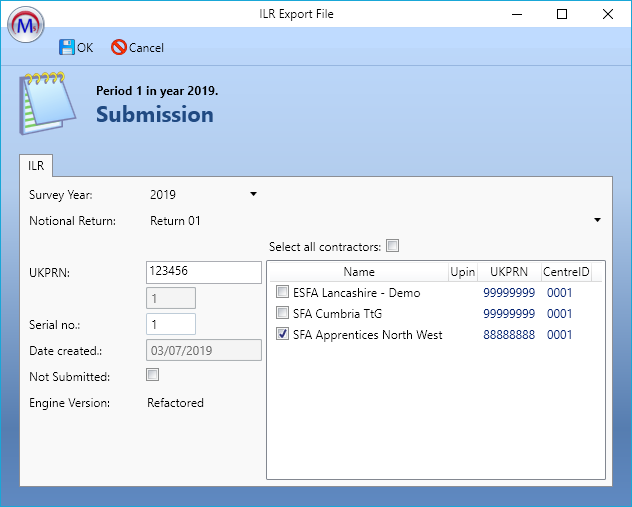
- Choose 2019 from the Survey Year dropdown box.
- Choose the Notional Return period.
- Amend the UKPRN as required.
-
Once ready, click OK.
Please be aware that the option to choose between the legacy and refactor export engines is not available for 2019/20 exports, as they are only produced using the new refactor engine.
-
Locate the submission by expanding the contract year and period using the arrows to the left. Click the submission to select it. The status will say Generate pending until the export data has been generated. It will then say File preparation finished. Please note that this may take a while, depending on the amount of data being exported.

- Edit opens the export and allows you to view and edit the export settings. Please note that not all settings can be changed once an export has been created.
- Generate processes the export and produces a text file showing any errors for each learner. This allows you to correct any errors and re-generate before the batch file is created. The generation progress is shown with the circular progress bar to the right.
- View Log shows any errors in the export. These should be investigated and resolved and the data re-generated before outputting the XML.
- Output XML creates the actual batch file. The file will be created at C:\Temp on the Maytas server.
- Get File lets you download the batch file once it has been created.
The 2019/20 ILR export has been tested and validated against version 2 of the ILR specification and other accompanying documents. The late release of the 2019/20 FIS from the ESFA and its current limited functionality means that we have not yet been able to test the ILR export with the FIS comprehensively. Further testing will be done as new versions of the FIS become available. As of this upgrade, the provider support manual is not yet available and so any changes required from it will be implemented in a future release.
While we have tested the ILR export to the best of our ability with the available specifications, there may be further issues which have not yet been identified. We also expect that future versions of the FIS and the ILR specification may require the export and/or FIS import to be changed to meet any new criteria. Any changes that are required will be implemented in a follow-up release of Maytas.
Migration of ILR export override flags
The following details whether ILR export flags are migrated from 2018/19 to 2019/20. For information on setting these flags, please contact Maytas support.
Force Export Flag
The 2018/19 force export flag is not copied to the 2019/20 force export flag. To override the ILR export and include a POT that does not meet the 2019/20 ILR export criteria, the 2019/20 export flag must be set.
Blocking Flags
The 2018/19 blocking flags are copied to the 2019/20 blocking flags. Aims blocked from the 2018/19 export will continue to be blocked in the 2019/20 export.
Funding Information
The funding information for 2019/20 in this upgrade is based on the funding rules for 2018/19, since full specifications were not available at the time of development. The 2019/20 funding information in this upgrade should be considered a beta version and is subject to change once future specifications have been published.

Completion Status, Outcome and Contact Preferences
Updated versions of the ILR 2018/19 tabs are included with this release which use new fields for outcome, completion status, restricted use indicator and preferred method of contact. These are referred to as the R14 fields. Data from the existing fields are migrated to them during the upgrade, and in most cases these values do not need to be altered. The R14 fields are what will be used for the 2018/19 ILR export and the existing fields will continue to be used from 2019/20 onwards.
The purpose of this change is to allow different values for 18/19 and 19/20 to be recorded, so that learners who completed in 18/19 who were on a break in learning or had an unknown outcome can be correctly included by the 19/20 ILR export. It is also important for separately maintaining the 18/19 and 19/20 codes for the contact preference fields (RUI) and (PMC), as this may be necessary for GDPR purposes. As with any other continuing learner, you should ensure that data is correct on the tabs for each contract year.
For late-notified leavers where the learner left in 18/19 but the data is entered during 19/20, it is important that you complete the above fields on both the 18/19 and 19/20 tabs, even though the learner has not continued into 19/20. This is to ensure the data is recorded in the existing / ongoing fields so that the correct data for these learners is included on reports.
ZESF Aims
The refactor ILR export will now generate ZESF aims for learners on scheme 47 where the relevant option is ticked in the new learner wizard:
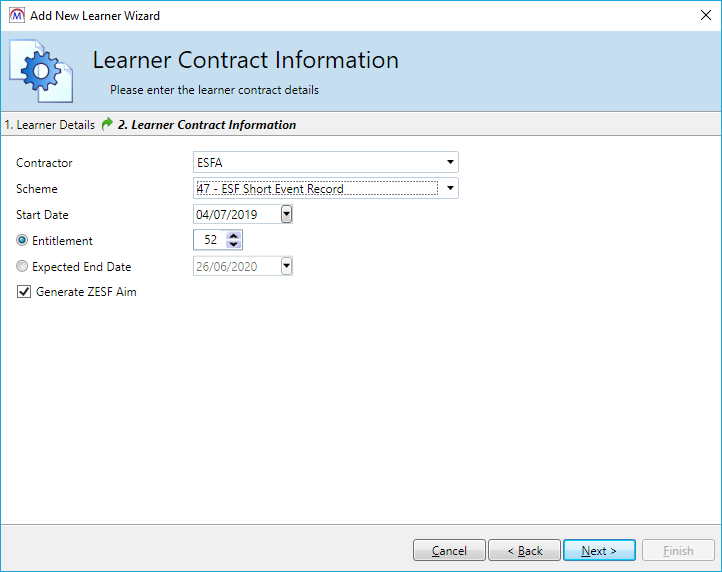
Previously, this was only possible with legacy exports.
LRS Web Service Certificate Renewal
The LRS are issuing new LRS certificates for use with the LRS and PLR web services which are utilised by Maytas. It is important that you install the new certificate before 21/09/2019 to ensure continuation of the services.
Instructions for this can be found on the Tribal Communities site:
OneFile Integration Updates
Several features in the OneFile integration have been updated. See here for more information on using the OneFile integration in Maytas.
Updated OneFile tab
An updated version of the OneFile tab is available for importing:
- In Maytas go to Tools on the toolbar and click Import on the Screens panel of the ribbon.
- Click Browse.
- Browse to the Maytas 5\Extras\Tabs folder of the upgrade.
- Select OneFile.m5tab and click Open.
- Click Next, then click Finish.
- Go to Home on the toolbar and click Sync.
Centre ID in centre mapping
When mapping centres to OneFile organisations, the centre ID is now displayed alongside the centre name so that it is clearer which centre is being mapped.
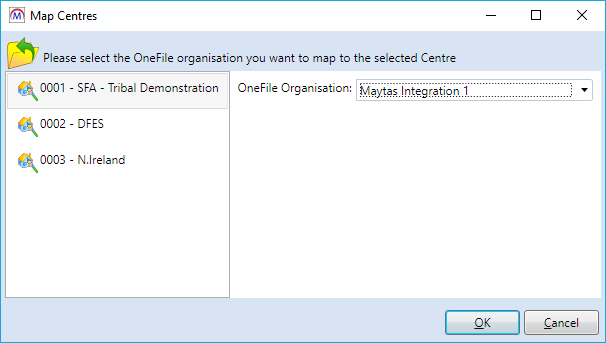
Branch name included with employer name
When an employer record is sent to OneFile, the branch name is now included (if one is entered) along with the employer name. If an employer with a branch name has already been sent to OneFile before this upgrade, uploading it again will update the existing record on OneFile with the branch name.
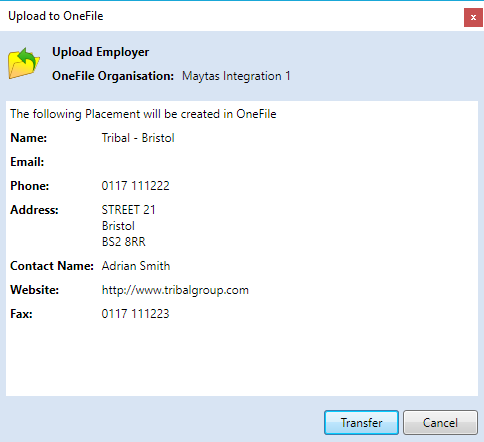
Extra learner fields included in upload
Four additional fields are now included when uploading a learner record to OneFile:
- Unique learner number (ULN) - TRAINEE.UNIQUELEARNERNUMBER
- Ethnicity - TRAINEE.ETHNICGROUP
- Gender - TRAINEE.GENDER
- Disability - TRAINEEDETAILS.DISABILITY
Search across all organisations
When uploading a learner, assessor or employer record to OneFile, Maytas will now check across all OneFile organisations to see if an existing record already exists, and if so, that record will be updated rather than creating a new one. This prevents duplicates being created in OneFile if the centre/organisation has changed since the record was first uploaded.
Usability Survey
As with previous major releases, Maytas users will be asked to complete a usability survey after the 5.18 upgrade (this will appear 30 days after the upgrade to allow for time using the updated system). The information gathered via the survey is anonymous and is used to improve the Maytas user experience. Only Tribal receives the results and we do not share the results with third parties. As always, we are very grateful for completed surveys as well as any additional feedback you have on Maytas.
Funding Rules Update
The funding calculation in Maytas for funding model 36 has been updated so that it uses the new employer co-investment rate of 5% for apprenticeships, as per the latest available specification and associated documents.